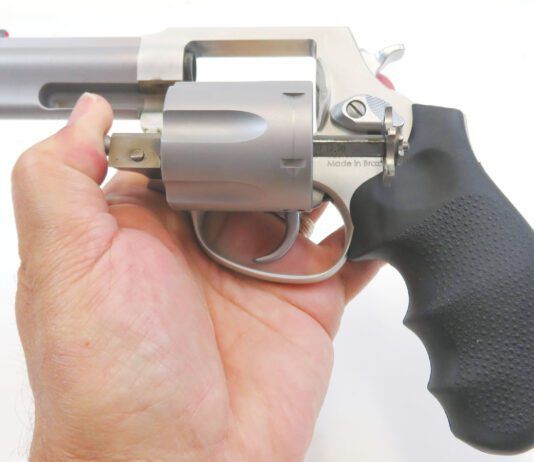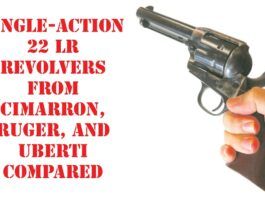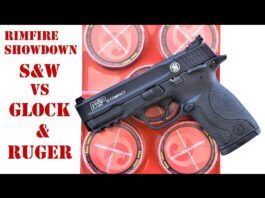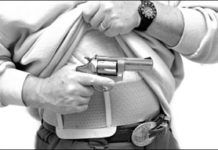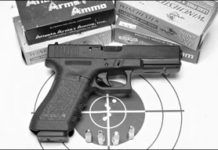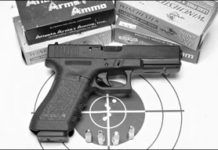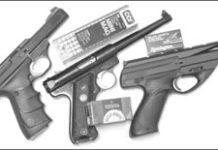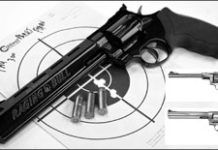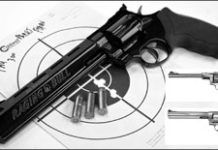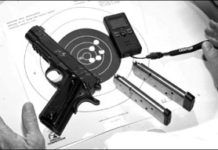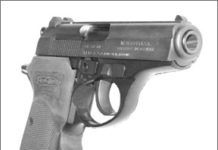.32-Caliber Wheelguns: Rugers SP101s Excel at Self-Defense
Full-Time-Double-Action 9mms: We Like SIG Sauer, H&K, Glock
In this test we shot three double-action-only pistols designed for duty or personal self defense. Medium to large in size, they carry few levers, and this snag-free characteristic also makes them attractive for concealed carry. Two of the three guns, the $879 Heckler & Koch P2000 LEM V2 and Sig Sauer's $749 P250 Two-Tone, utilize a hammer and firing pin for ignition. The $599 Glock G17, arguably the gun that started the polymer DAO revolution, relies on the preparation and release of a striker to impact the primer. Despite any similarities between the guns, this test challenged us to master vastly different trigger techniques.
We began our tests from the 25-yard line supported by bench and sandbag. What better way to learn a trigger than limiting variables to grip, sight alignment, and a controlled press? We then added a second test. This would require landing rapid-fire hits on an 8.5-by-16-inch target from a distance of 5 yards, two shots at a time. Our shooter began each string of fire standing unsupported with a two-handed grip and sights on target but with finger off the trigger. We pasted a black 1-inch-wide dot in the center to provide a point of aim. Upon audible start signal from our CED electronic timer, we engaged the target as quickly as possible. Given that each stroke of the trigger both prepared and released the striking mechanism, we wanted to know how quickly and accurately we could land two hits on target one after another. We fired ten pairs and looked for a total of 20 hits on target. This test was performed twice. The second time we concentrated on applying what we learned from the first run. The rapid-fire test was performed firing one of our favorite practice rounds, Black Hills' 115-grain FMJ ammunition sold in blue 50-round boxes. From the benches we tried Winchester's new 105-grain jacketed softpoint Super Clean NT (nontoxic) ammunition; 124-grain full-metal-jacket rounds by Winchester USA, and 147-grain Subsonic jacketed hollow point Match rounds by Atlanta Arms and Ammo. Here is what we learned.
Full-Time-Double-Action 9mms: We Like SIG Sauer, H&K, Glock
In this test we shot three double-action-only pistols designed for duty or personal self defense. Medium to large in size, they carry few levers, and this snag-free characteristic also makes them attractive for concealed carry. Two of the three guns, the $879 Heckler & Koch P2000 LEM V2 and Sig Sauer's $749 P250 Two-Tone, utilize a hammer and firing pin for ignition. The $599 Glock G17, arguably the gun that started the polymer DAO revolution, relies on the preparation and release of a striker to impact the primer. Despite any similarities between the guns, this test challenged us to master vastly different trigger techniques.
We began our tests from the 25-yard line supported by bench and sandbag. What better way to learn a trigger than limiting variables to grip, sight alignment, and a controlled press? We then added a second test. This would require landing rapid-fire hits on an 8.5-by-16-inch target from a distance of 5 yards, two shots at a time. Our shooter began each string of fire standing unsupported with a two-handed grip and sights on target but with finger off the trigger. We pasted a black 1-inch-wide dot in the center to provide a point of aim. Upon audible start signal from our CED electronic timer, we engaged the target as quickly as possible. Given that each stroke of the trigger both prepared and released the striking mechanism, we wanted to know how quickly and accurately we could land two hits on target one after another. We fired ten pairs and looked for a total of 20 hits on target. This test was performed twice. The second time we concentrated on applying what we learned from the first run. The rapid-fire test was performed firing one of our favorite practice rounds, Black Hills' 115-grain FMJ ammunition sold in blue 50-round boxes. From the benches we tried Winchester's new 105-grain jacketed softpoint Super Clean NT (nontoxic) ammunition; 124-grain full-metal-jacket rounds by Winchester USA, and 147-grain Subsonic jacketed hollow point Match rounds by Atlanta Arms and Ammo. Here is what we learned.
John Lott Interview with Glenn Beck re: “Heller” Supreme Court Case
Full-Size .22 Long Rifle Autos: We Love Rugers 6-Inch Mark III
Long-Barreled .44 Magnum Revolvers: Bravo for the Bull
Long-Barreled .44 Magnum Revolvers: Bravo for the Bull
Adding a Third Lock to a 1917 S&W
SHOT Show Media Day Rock-and-Roll Shooting Party
.45 ACP Matchup: Were Mostly Sold on Kimbers Custom SIS RL
In this evaluation, we will look at three .45 ACP 1911-style pistols. Not too long ago, this would mean three pistols that looked almost exactly alike. But today's 1911 may contain as many different components as the total number of its parts. For example, the new Brownells catalog devoted solely to the 1911 lists as many as 27 different styles of custom hammers. Thus, our test guns offered several different variations on the 1911 platform.
Our three test guns were the $1421 Kimber Custom SIS RL, Springfield Armory's $1332 Loaded Operator MC, and the $1129 Para Ordnance P14-45S GR. Each gun fired from a 5-inch barrel supported at the muzzle by a bushing and could be referred to as full-size "Government" models. But the Para Ordnance pistol offered higher capacity, feeding from a wider magazine wherein the rounds were piled in a zigzag pattern rather than stacked in a single column. All three guns varied in the designs of their grips, sights, and thumb safeties.


























